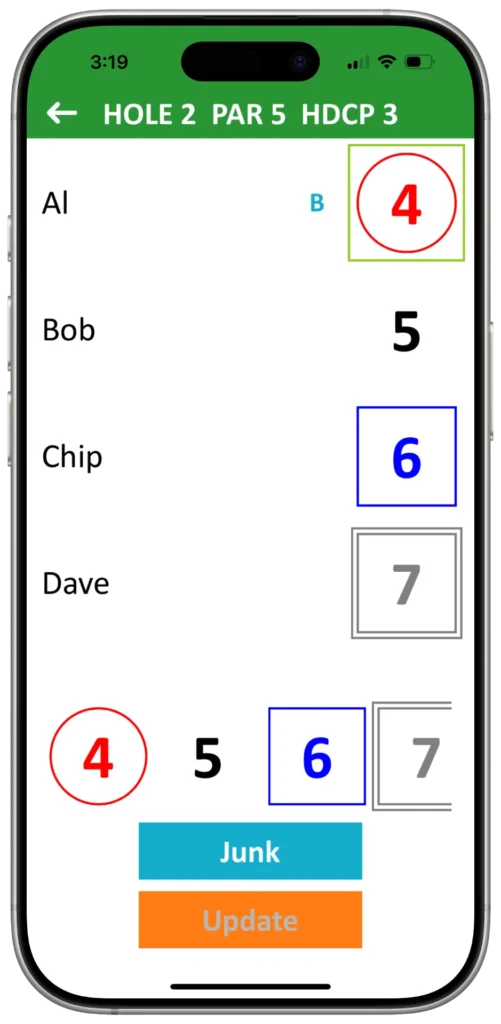Are you new to golf and unsure of what to do when you grab a scorecard? There certainly are a bunch of numbers and blank boxes on one so it can be somewhat intimidating. Even seasoned golfers often want nothing to do with keeping score or looking at the card. Well, knowledge is power and by the end here you’ll not only understand how to read a golf scorecard but also confidently fill one out. It’s simpler than you think and mastering it may actually enhance your enjoyment of the game. Playing golf is hard enough without being further challenged by confusion with the card. Golf scoring explained, let’s dive in.
Historical Aside: the oldest golf scorecard dates back to 1820 in Musselburgh Scotland. While likely that cards were informally used before then, they became more widespread with the advent of affordable printing technology in the late 19th century. Nowadays, more and more people are turning to digital cards kept right on their smartphones.
Your Golf Scorecard: A Roadmap to the Course
At its most basic, a golf scorecard is a document used to record a golfer’s score on each hole of a golf course. Think of your golf scorecard as a detailed map for your round. It guides you through each hole, tells what to expect, and logs your progress. While scorecards obviously vary between courses, they all share common elements. Let’s break down each section so you can keep score, understand golf handicap, track matches and manage all the other details.
Hole Numbers (1-18)
This is the easiest part. You’ll see a row of numbers, typically from 1 to 18, representing each hole on the golf course. Most courses have 18 holes but some only have 9, or 3 sets of 1 to 9 for a 27-hole course. Alternatively, some cards are organized vertically using a column instead of a row for the hole number and other fields.
Horizontally oriented card with hole numbers in a row. Courtesy Alpine Golf Club NJ
Vertically oriented card with hole numbers in a column. Courtesy Pine Valley Golf Club NJ
Par for Each Hole: Your Target Score
Par in golf is a fundamental concept and understanding par is key to learning golf score and knowing how well you’re doing. For each hole, you’ll see a number listed under “Par.” This number represents the expert-level target score for that hole – the number of strokes a skilled golfer is expected to take to get their ball from the tee into the hole. Almost all golf holes are either par 3, par 4 or par 5.
- Par 3: These are the shortest holes, designed to be completed in three strokes (one off the tee plus two putts)
- Par 4: The most common type of hole, requiring four strokes (one off the tee, one approach shot and two putts)
- Par 5: The longest holes, where five strokes are considered par (one off the tee, two approach shots and two putts)
As you can see, par always leaves room for two putts while also assuming you hit the green (the putting surface) in 1, 2 or 3 shots, respectively. Leaving the window open for scores even better than par!
Yardage/Distance: How Far Are We Hitting?
Attached to the par for each hole, you’ll find a yardage or distance. These numbers tell you the length of each hole (in yards or meters) from a specific set of tee markers, customarily measured from a base plate for each tee to the center of the green.
- You’ll probably see multiple yardage numbers for each hole, usually color-coded. These colors correspond to the different tee boxes on the course (e.g. black, blue, white, gold, red)
- Generally, the longer the yardage, the more challenging the hole. As a beginner, you’re best off playing from the forward tees which offer a shorter, more manageable golf course layout. Focus on the fundamentals and enjoy the game
Irrespective of skill, try choosing tees that make the course play to a comfortable yardage for your game. Your average driving distance provides a good rule of thumb. Here’s a handy reference from TPC Danzante Bay:
| Average Drive | Recommended Tees(Total Yardage) |
| 300 yards | 7,150-7,400 yards |
| 275 yards | 6,700-6,900 yards |
| 250 yards | 6,200-6,400 yards |
| 225 yards | 5,800-6,000 yards |
| 200 yards | 5,200-5,400 yards |
| 175 yards | 4,400-4,600 yards |
| 150 yards | 3,500-3,700 yards |
| 125 yards | 2,800-3,000 yards |
| 100 yards | 2,100-2,300 yards |
Handicap/Stroke Index (HCP/SI): Leveling the Playing Field
This is where it gets more interesting. The Handicap/Stroke Index (HCP/SI) column is vital for fair play, especially in competitive or friendly handicap-adjusted rounds.
The Stroke Index (or Handicap) for a hole indicates its difficulty relative to the other holes on that specific course. The numbers range from 1 to 18 (or 1 to 9 on a 9-hole course)
- The Rank: 1 is the most difficult hole on the course while 18 is the easiest hole
- Its Role: The Stroke Index value identifies the holes a higher-handicap player receives “extra” strokes on to make the game more equitable against a lower-handicap player. We’ll touch more on this when we discuss net scores and stroke allocation
Note that the card may have more than 1 set of handicap index values (and par values as well) and these pertain to different sets of tees. If unclear, check with the Pro Shop or Starter to see which set of values apply to the tees you’re playing from.
Player Name & Handicap Allowance: Who you’re playing with
Before you hit your first shot, take a moment to fill out the top of your scorecard and be sure to record the date somewhere, especially if you’re going to save the card.
- Player Name: Write your name and the names of your playing partners (in separate rows if the hole numbers run across the card or separate columns if the hole numbers run top to bottom)
- Handicap Allowance: This is where you’ll write down Course Handicap, your personal golf handicap and those of your playing partners. Put this beside player name if there’s no column for it e.g. Dave Smith (28). If you don’t have an official handicap yet you can use an estimated one (e.g. 36 for beginners) or just leave it blank for casual rounds. This number will be used later for calculating your net score and as we move forward into match play, to identify strokes per hole
Stroke Recording Columns: Marking Your Shots
The most basic function of the scorecard is to capture the hole totals, the number of strokes it took from the tee to the cup. For each hole (1-18), record the number of strokes it took to get the ball into the hole.
- Simple guidance: After you complete a hole, count every shot you made, including penalty strokes. Write the number in the box corresponding to that hole under your name (along with score(s) for your playing partners if you’re keeping score for everyone)
- Make it a habit to verbally confirm scores with your playing partners after each hole
Example: If you took 6 shots on Hole 1, write “6” in the box for Hole 1 under your name. On the other hand, some people prefer to keep score vs par instead so if Hole 1 was a par 4 they’d write +2 down – it all works out the same, just be consistent.
Common Scoring Terms: Your Golf Lexicon
As you get into golf, you’ll hear these terms all the time. They describe scores relative to par on a given hole. Grasping these is part of golf terms for beginners.
- Par: Taking the exact number of strokes designated for the hole (e.g. 3 shots on a Par 3) – Well done!
- Birdie: One stroke under par (e.g. 2 shots on a Par 3) – Great achievement!
- Eagle: Two strokes under par (e.g. 3 shots on a Par 5) – Even rarer!
- Bogey: One stroke over par (e.g. 4 shots on a Par 3) – Still respectable
- Double Bogey: Two strokes over par (e.g. 5 shots on a Par 3) – Not so good
- Triple Bogey: Three strokes over par. (e.g., 6 shots on a Par 3) – Forget this
- Albatross (or Double Eagle): Three strokes under par (e.g. 2 shots on a Par 5) – Super rare!
- Hole-in-One (or Ace): A dream shot, getting the ball in the hole in one stroke (almost always on a Par 3) – Take a picture, mount the ball!
You eventually also see these values highlighted with shapes and/or colors – a circle around the score for birdie (red), a square for bogey (blue), double square for double bogey (gray), double circle for eagle (red) and par unadorned (black).

Sample format for Birdie, Par, Bogey and Double Bogey. Courtesy Golf Crow
Front 9 (OUT) & Back 9 (IN) Totals
You’ll also see sections labeled “OUT” and “IN”.
- OUT (Front 9): This is where you’ll sum up all the strokes for holes 1 through 9
- IN (Back 9): This is where you’ll sum up all the strokes for holes 10 through 18
These sections help you keep track of progress halfway through the round and at the end. Following that there will also be a “TOTAL” section where you add up the OUT and IN values to get a total score.
Gross Score vs Net Score: Understanding Your True Performance
Here’s another point of interest for beginners that’s actually quite simple once you get it.
- Gross Score: This is your raw score – the total number of strokes you took for the entire 18-hole round (OUT total + IN total). It’s your “shots taken” count. Note that Gross Score per hole is capped at a Max Score of Net Double Bogey or Par + 2 + Handicap Strokes. In general, you receive a Handicap Stroke on any hole with a Handicap Index value lower than your Course Handicap (more on this later)
- Net Score: This is your Gross Score minus your Course Handicap (Handicap Allowance). The net score is what truly levels the playing field, as it adjusts performance based on your skill level
- Simple Calculation:
- Add your “OUT” total and your “IN” total to get your Gross Score
- Subtract your Course Handicap from your Gross Score
- The result is your Net Score
- Example: If your Gross Score is 100 and your Course Handicap is 25, your Net Score is 75 (100 – 25 = 75)
- Why it matters: In most friendly and official competitions, there’s a category winner determined by Net Score, not just Gross Score. This allows golfers of lesser skill level to compete more fairly and give everyone something to play for
- Net Score per Hole: You can also record Net Score on a per Hole basis, subtracting any Handicap Strokes from Gross Score. This too may also be recorded relative to Par e.g. +1, 0, -1
- Simple Calculation:
Marker/Attest Sections: For Official Rounds
At the bottom of the scorecard, you’ll see sections for “Marker” and “Attest.”
- Marker: The person who also kept your score (like one of your playing partners). They sign here to verify the score
- Player/Attest: You (the player) sign here to confirm that you agree with the score recorded. Make sure everything adds up properly before signing or you could be disqualified (see Roberto Vincenzo 1968 Masters for a heartbreaking example)
These signatures are required for official rounds or when submitting scores for handicap purposes, as they foster accuracy and integrity.
Additional Values Golfer Track: Matches & Stats
As you get more into golf and start competing in match or best of group play you can use other available rows on the scorecard as well. Many golfers also record personal stats on the card. Match Play, Points-based Matches and Best Of warrant further discussion and will be explored in a future post.
- Match Play: A +/- indicator to show whether you won a hole or how many holes you’re up or down in a match vs another player or team
- Points-based Match: How many points were earned on the hole e.g. Stableford, Skins or Wolf game
- Best Of: Track the best 1, 2, or 3 per hole net score from your group per for later comparison with another group or groups
- Fairways: Use an arrow (left, center, right) to indicate what direction your tee shot went
- Greens: Flag greens you hit in regulation (in 1 stroke for a par 3, 2 strokes for a par 4 and 3 strokes for a par 5)
- Putts: How many putts you needed to hole out once you were on the green
- Junk: Identifies extraordinary scoring like chippies, sandies and greenies
- Penalty Shots: Helps explain why a hole score was so high
As you might infer, tracking all this stuff can have you quickly running out of space on a physical card, there’s only so much room!
Conclusion: How to Read a Golf Scorecard
Congratulations! You’ve just completed the ultimate guide to reading a golf scorecard. By now, you should feel much more confident around this seemingly complex piece of paper.
Remember, understanding a scorecard isn’t just about keeping track of numbers; it’s a way to fully engage with the game, appreciate the course layout, and even set personal goals. From identifying what par is to navigating the stroke index and correctly calculating net score, you now have the tools to make your golfing experience more enjoyable.
So, head to the course, grab a scorecard, and put your newfound knowledge to the test. The more you do it, the more natural it’ll become. Go forth and score your round – you’ve got this.
Is There an App for That? Yes, Golf Crow: The Best Golf Scorecard App!
Most golfers who score a round by hand on a physical card wind up leaving it behind or throwing it out. Why waste all that valuable information you just spent an entire round recording? Believe it or not, there’s a wealth of data here that can help improve your game and more importantly, build lasting memories.
Not interested in messing with paper and pencil and prefer the convenience of your phone? If you love golf and are ready to try the best golf scorecard app that simplifies scoring, tracks your matches, and gives insightful stats without the fuss of paper, you should check out Golf Crow. It’s designed to make your on-course experience smoother and more focused on the game itself with the added benefit of a digital record and the ability to compare results with playing partners. It also features a patented slider-based hole score entry system. Give it a try and see how easy golf scoring can be!



